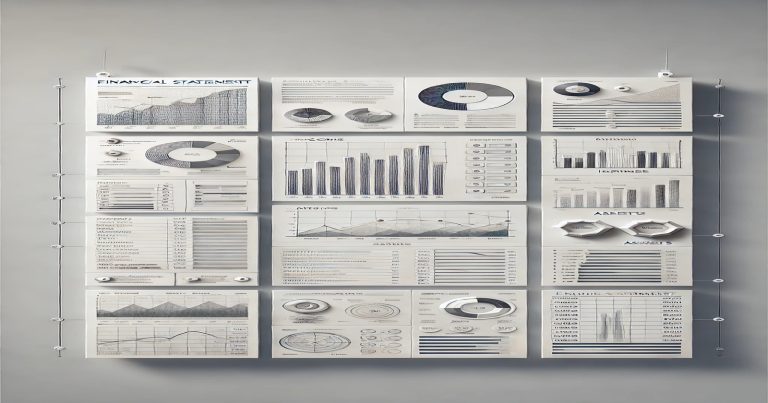Students and professionals alike can benefit from vertical analysis of financial statements to get a better understanding of the components of a company’s financials. It illustrates how any given entry is connected to a total amount in the same statement. For instance, each item on an income statement becomes a percentage of total sales. It can help visualize the weight of each cost or asset at a single glance. Vertical analysis of financial statements provides an easy view of internal trends and allows for comparison between businesses of varying sizes. It helps in giving a clearer perspective on the company’s profitability.
What is a Financial Statement?
Financial statements are reports that detail a company’s financial performance. These filings allow the public to see what a company owns and owes, how much money it makes and how it spends its money. All businesses, whether they are large or small, need to generate these statements to monitor their actions.
Types of Financial Statements
The most common financial statements are four types:
- Income Statement – This displays a company’s revenues and costs. It indicates whether the company has made a profit or loss.
- Balance Sheet: This shows what the company has (assets) and owes (liabilities). It also displays the owner’s equity.
- Cash Flow Statement: Tells where the business generated cash from and where it was spent.
- Statement of Changes in Equity – This report illustrates how money in the owner’s pockets changed over time. Each statement provides a different perspective on a company’s performance. Accountants use them to determine if a business is strong or weak. So did investors before investing in a company.
This is where common-size financial statements can be quite useful. A common-size statement is created by converting all items to a percentage for the respective statement. This makes it simple to measure companies against one another or different periods.
Vertical Analysis of Financial Statements
Vertical analysis makes these statements easy to interpret in accounting. What it does nicely is in the percentage format; it shows you quickly where the most money goes or where the returns are. Again, the income statement will show the cost of goods sold or operating expenses as a percentage of revenue.
Example of Vertical Analysis: Analysis of an Income Statement
Vertical Analysis Of an Income Statement The task of vertical analysis of an income statement is to make us aware of the weight of every item in the statement. This analysis also displays each line as a percentage of total revenue. This way, we observe how much of the sales is spent on, e.g., cost of goods sold, staff salaries, or marketing.
Purpose of Vertical Analysis in the Income Statement
Vertical analysis is used to demonstrate cost control and profit trends when used on the income statement. It aids in the comparison of one company with another, irrespective of whether both are of the same size or not. If you use percentages, you can compare a company with ₹10 crore in sales and a company with ₹10 lakh in sales.
Thus, if two companies spend 30% of sales on marketing, you may say they act the same (they behave the same), even if their actual spending is different.
| Income Statement Item | Amount (₹) | Vertical Analysis (%) |
| Total Revenue | 10,00,000 | 100% |
| Cost of Goods Sold (COGS) | 6,00,000 | 60% |
| Gross Profit | 4,00,000 | 40% |
| Operating Expenses | 2,00,000 | 20% |
| Net Profit | 2,00,000 | 20% |
Vertical Analysis Example for Income Statement
Now, looking at the above table, we know that 60% of revenue goes to COGS. 20% goes to operating expenses, and the company keeps the other 20% as profit.
How to Do Vertical Analysis?
- Select a base amount (for the income statement, total revenue).
- Normalize each item based on that base amount.
- Then, to convert to a percentage, multiply the numbers by 100.
- The vertical analysis formula is easy to understand but a powerful one. It helps managers make more optimal decisions by identifying areas that require budget control or enhancement.
Vertical Analysis vs Horizontal Analysis
Accountants perform vertical and horizontal analysis to gain insight into financial data. They both inform decisions, but they are concerned with different things. In this section, we will briefly clarify how they are different.
What is the Difference?
Content Introduction: What is Vertical analysis vs. horizontal analysis? These two terms are commonly mixed up with one another, but they have quite different functions.
- Vertical Analysis: It Compares items within the same financial statement by showing them as a percentage of a total figure, such as sales or assets.
- Horizontal Analysis: It compares the same items for different periods. It reflects how values have shifted over time.
Difference between Vertical and Horizontal Analysis Table
| Feature | Vertical Analysis | Horizontal Analysis |
| Focus | Single period | Multiple periods |
| Format | Percentages of a base figure | Percentage or amount change |
| Purpose | Shows item weight | Shows growth or decline |
| Use | Comparing companies or departments | Trend analysis |
Why Compare the Two?
Both tools are useful. You perform vertical analysis of the balance sheet: so how much of total assets are current assets, and how much equity is there? You perform horizontal analysis to ensure that equity has increased over the years.
For instance, you can see that every year, advertising costs are equal to 10% of revenue (vertical), but in rupees, it has gone from ₹50,000 to ₹1,00,000 in five years (horizontal).
Together, both types of analysis paint a clearer financial picture. Both these aspects are important for business students and finance professionals in India to learn at the grassroots level to analyze a company properly.
What is the Vertical Analysis Formula
In accounting, vertical analysis is the formula that helps extensively to represent data in the easiest way possible. It converts numbers into percentages so that users can see how much certain items matter within a financial statement.
Formula
Here is the basic vertical analysis formula:
(Individual Item / Base Amount) x 100
All line items become percentages with this simple formula. Total revenue is the base amount in the income statement. On the balance sheet, it is total assets.
Application of Vertical Analysis in Accounting
Vertical analysis is useful for accountants to identify troublesome areas. As expenses grow relative to sales over the years, the company must respond. The analysis also aids budgeting. Managers can establish spending limits as a portion of sales.
Here’s another example of a vertical analysis as applied to the balance sheet.
| Balance Sheet Item | Amount (₹) | Vertical Analysis (%) |
| Total Assets | 20,00,000 | 100% |
| Cash | 2,00,000 | 10% |
| Accounts Receivable | 3,00,000 | 15% |
| Inventory | 5,00,000 | 25% |
| Fixed Assets | 10,00,000 | 50% |
In the vertical analysis of the balance sheet, we note that 50% are fixed assets. This may show low liquidity. If it’s 25%, we need to see if the stock is moving or stuck.
Purpose of Vertical Analysis
- The goal of vertical analysis is to provide a more intuitive and comparable view of the data. Students may be confused by a table or chart with numbers. However, they tend to be read quite nicely, even by school-level students, when shown in percentages.
- It similarly assists non-finance end users. Vertical analysis results help non-accounting owners, investors, and managers make better decisions.
Pros and Cons of Vertical Analysis
Vertical analysis is very helpful but has its limitations:
- It cannot visualize time-based transformation.
- If the base figure is very high or low, it may give a wrong idea.
- It doesn’t indicate whether a thing is good or bad, only how large it is.
- Hence, we should use it with other tools, such as horizontal analysis and ratio analysis, for better results.
Relevance to ACCA Syllabus
ACCA Financial Reporting and Strategic Business Reporting include vertical analysis. This enables students to compare the scale of each line item in the financial statements to a baseline number, which is helpful for the assessments of overarching financial health. Required to explain profits and decide on business directions. Direct questions on ratios, including vertical and horizontal analysis, are frequently asked in ACCA exams since most questions will involve interpretation of financial statements.
Vertical Analysis Of Financial Statements ACCA Questions
Q1: In vertical analysis, each line item in the income statement is expressed as a percentage of
A) Total liabilities
B) Net profit
C) Total revenue (sales)
D) Operating income
Ans: C) Total revenue (sales)
Q2: A vertical analysis of a balance sheet typically shows each item as a percentage of
what?
A) Equity
B) Total assets
C) Gross profit
D) Net assets
Ans: B) Total assets
Q3: The best for vertical analysis:
A) Predicting economic trends
B) Comparing company size
D) Analysis of financial ratios (time-series or cross-section)
D) Calculating depreciation
Ans: C) Longitudinal audits of financial ratios
Q4: If cost of goods sold is 60% of sales in a vertical analysis, what does that mean?
A) 60% of total assets are related to costs
B) 60% of company sales revenue pays for direct costs
D) Cost control giving 60% net income
Ans: B) 60%Of the Company’s sales revenue goes in meeting direct costs.
Q5: Which statement is more yours using base Total Assets in vertical analysis?
A) Income Statement
B) A Statement of Changes in Equity
C) Balance Sheet
D) Cash Flow Statement
Ans: C) Balance Sheet
Relevance to US CMA Syllabus
Vertical analysis is an important topic under the umbrella of “Financial Reporting”, in Part 1 CMA USA. It supports management decision-making by summarizing large data sets and showing how financial features correlate to the company’s sales or total assets. It’s key for internal reporting and for performance assessment, as well.”
Vertical Analysis of Financial Statements CMA Questions
Q1: What is the purpose of vertical analysis in managerial accounting?
A) To prepare tax returns
B) Decrease the cost of capital
C) To express the relative size of financial statement items
D) To… [See the full post at: AD]
Ans: C) Measure the size of the financial statement items relative to each other.
Q2: When performing vertical analysis, depreciation expense from the income statement is usually expressed as a percentage of:
A) Total assets
B) Operating income
C) Total revenue
D) Net working capital
Ans: C) Total revenue
Q3:Standard costing is important in managerial accounting because it helps you to:
A) Enables cost benchmarking with industry benchmarks
B) Calculates ROI
C) Recites shareholder returns
D) Identifies fraud
Ans: A) Ensures costs can be compared with the industry standard
Q4 If Administrative cost is 25 % of total revenue then what it indicates in vertical analysis?
A) The firm has no profit
B) Operating margins are high
C) Admin costs are one in four sales pounds
D) Sales are declining
Ans: C) Admin accounts for 25% of sales of sales is spent on admin.
Relevancy for US CPA Syllabus
Vertical analysis is included in the syllabus of US CPA as a part of FAR (Financial Accounting and Reporting) Section. It is useful for reviewing and comparing financial statements, especially over time or between entities. This system helps CPA candidates to evaluate performance and identify financial trends.
Vertical Analysis- Financial Statements- US CPA Questions
Q1: When doing vertical analysis on the income statement, of what will all other items use as denominator (base)?
A) Net income
B) Total equity
C) Sales (or Revenue)
D) Total assets
Ans: C) Sales (or Revenue)
Q2: When would you use vertical analysis?
A) Examination of Forex Exposure
B) Analyzing liquidity only
Type C) Profit and loss account inter-year comparison
D) A tax consistency reconciliation
Ans: C) Comparison of income statements of different years
Q3: Selling & administrative expense are 40% in the vertical analysis. What does this imply?
A) Revenue is overstated
B) Sales must be cut
C) 40% of sales is for operating costs
D) Gross Profit Margin < 0
Ans: C) 40% of the income is consumed in operating expenses.
Q4: What is vertical analysis in the audit?
O) Helps to catch variations in parts of fiscal products
B) Sets up depreciation schedules
C) Calculates tax liability
D) Tests internal controls
Ans: A ) Enables distinction twixt the variations of the components of balance sheet
Q5: In the vertical analysis of a balance sheet, equity in the balance sheet represents 40% in total assets. This implies:
A) It’s a very liquid company
B)The firm is very leveraged
C) owners hold 60% of assets financed
D) The current ratio is 2:1
Answer: C) equity financing 40% of assets
Relevance to CFA Syllabus
As per CFA curriculum (especially Level I and II), vertical analysis falls under Financial Reporting and Analysis. It teaches candidates how to assess financial strength and risk, compute peer comparisons and value performance metrics in order to determine their relative importance. It enables financial modelling and valuation work.
Vertical Analysis of Financial Statements CFA Questions
Q1: Vertical analysis is a financial statement analysis technique that allows an analyst to:
A) Build regression models
B) Comparison of items to % of base number
C) Conduct scenario analysis
D) Prepare the consolidated financial statement
Ans: B) Comparison of items to % of base number
Q2: A financial analyst is comparing the financial performance of the following two firms using common-size income statements.
A) Trend analysis
B) Cash flow analysis
C) Vertical analysis
D) Inventory valuation
Ans: C) Vertical analysis
Q3: Vertical analysis does not have which not advantage?
A) It allows comparisons across firms
(B) changes to the cost base
C) Opts for compound growth in dollars
D) Functions to check for modifications in data
Ans: C) Opts for compound growth in dollars
Q4: Vertical analysis is used to analyze which of these?
A) Market share
B) Industry cycles
C) General equilibrium of financial statement elements
D) Currency fluctuations
Ans : C) Proportion of financial statement line items
Q5: What is an income statement vertical analysis in which net income is 10% of sales?
A) High fixed cost
B) Profit margin
C) Liquidity position
D) Leverage level
Ans: B) Profit margin


